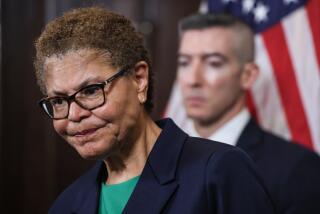Honig Takes the Gann by the Horns : Schools Chief Challenges the Weakest Link in the Tax Revolt
- Share via
The heated exchanges between the governor and the state superintendent of public instruction represent far more than the annual political disagreements over the budget. Rather, they signify the beginning of a battle that could be a watershed for the California tax revolt.
George Deukmejian was reelected last November as the governor who supposedly brought California from the brink of bankruptcy to fiscal solvency; three months later the state is awash in fiscal troubles for which there are no easy answers. Tax revenues have been stagnant, program costs are up, the reserve is down and the governor has had to make mid-year budget cuts just to keep the current year in balance. His proposed budget for next year promises to be worse--austerity in nearly every program, cutbacks for many, little to cheer about from almost any quarter.
In the case of education the Deukmejian Administration proposes robbing Peter to pay Paul, taking money away from important programs in order to appear to help schools cope with burgeoning class sizes. The state’s schools chief, Bill Honig, has called the budget a disaster for education and has accused the governor of reneging on his commitment to schools. Deukmejian lashed back with an uncharacteristically personal attack, yet at the same time he raised a fair question: In an era of strict spending limits and resistance to new taxes, where can we find the money for education or, for that matter, anything else?
The fact is that the state has gotten itself into a fiscal trap from which there is no exit without a reexamination and restructuring of the legacy of the tax revolt of 1978. It is an ideological straitjacket: State and local governments are permitted no real increase in spending after 1979, irrespective of economic growth or changes in society. And under no circumstances can any taxes be raised. The result is a budgetary war of all against all: No one gains without someone losing; if we need to lock away more prisoners, we may just have to give children less education.
The Gann spending limit, passed in 1979, is the weakest link in the tax revolt. By tying state and local spending only to inflation and population growth, it prevents government from reaping any dividends from a growing economy, even to cover the costs of growth. The limit had little effect through the years of high inflation and economic stagnation. Now that state spending has reached the ceiling, the unworkability of the Gann limit finally is clear.
Because the limit is so irrational, various interests are attempting end runs around it. Last year the highway lobby, with business support, sought an exemption for transportation spending. This year advocates for schools, courts and (again) transportation have suggested that the limit should not apply to them, or have structured their spending proposals to get around it.
So far the Administration seems interested in pressing the spending agenda that is implicit in the Gann limit: fee increases for programs supported by users, reliance on bonds for highways and other capital outlays, transfers of money from the state to local government (if local spending limits permit), and cuts in discretionary programs in favor of ongoing obligations, particularly prisons. These options will be exhausted quickly and are patchwork in nature; in the case of excessive reliance on bond financing, they mortgage our future.
Now a consensus solution to the irrationality of the Gann limit is emerging: Amend the limit to permit it to rise with the growth of per-capita income. A recent poll showed that while voters overwhelmingly support the maintaining of state and local spending limits, they also strongly believe that those limits should be allowed to grow along with the economy. This simple correction should be taken to the voters in the next statewide election in June, 1988. If supported by a broad coalition that includes business, it stands a good chance.
The tax side of the equation is more difficult. Voters in some counties have approved sales-tax increases for transportation, and a few revenue “enhancements” have made it through the two-thirds vote restriction in the Legislature, but nothing close to a consensus on new taxes has emerged. And even if the state could reap a small windfall from conformity with the new federal tax law, the Gann limit would have to be lifted first in order for significant new dollars to be spent.
The Democrats have been on the defensive ever since the tax revolt; tarred as big spenders, they have been unable or unwilling to challenge the conventional political wisdom of the 1980s. Now Honig has taken the lead: He has already called for a change in the Gann limit, and is willing to stump for the undeniable need for more money for our schools.
Some are saying that Honig is using the state’s fiscal mess for political opportunity, and that he is building support to run for governor. It can hardly be called opportunistic to tell California voters that their much-admired tax revolt is badly flawed and needs reworking. Some might even call it leadership.
It is unfortunate that the governor has chosen to hunker down in the trenches of right-wing partisanship. He would be better advised to look at some poll data, listen to his business-community friends, keep his eye on the problems brewing in California’s future, and at least join the effort to make a modest correction to the Gann limit.
More to Read
Get the L.A. Times Politics newsletter
Deeply reported insights into legislation, politics and policy from Sacramento, Washington and beyond. In your inbox twice per week.
You may occasionally receive promotional content from the Los Angeles Times.










